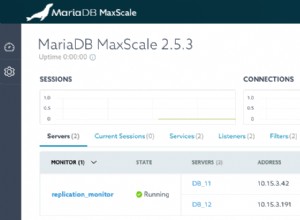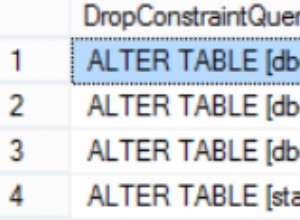SQL Server 2012+ seulement
Vous pouvez utiliser SUM fenêtré :
WITH cte AS
(
SELECT *,
1.0 * Revenue/SUM(Revenue) OVER(PARTITION BY [User]) AS percentile,
1.0 * SUM(Revenue) OVER(PARTITION BY [User] ORDER BY [Revenue] DESC)
/SUM(Revenue) OVER(PARTITION BY [User]) AS running_percentile
FROM tab
)
SELECT *
FROM cte
WHERE running_percentile <= 0.8;
SQL Server 2008 :
WITH cte AS
(
SELECT *, ROW_NUMBER() OVER(PARTITION BY [User] ORDER BY Revenue DESC) AS rn
FROM t
), cte2 AS
(
SELECT c.Customer, c.[User], c.[Revenue]
,percentile = 1.0 * Revenue / NULLIF(c3.s,0)
,running_percentile = 1.0 * c2.s / NULLIF(c3.s,0)
FROM cte c
CROSS APPLY
(SELECT SUM(Revenue) AS s
FROM cte c2
WHERE c.[User] = c2.[User]
AND c2.rn <= c.rn) c2
CROSS APPLY
(SELECT SUM(Revenue) AS s
FROM cte c2
WHERE c.[User] = c2.[User]) AS c3
)
SELECT *
FROM cte2
WHERE running_percentile <= 0.8;
Sortie :
╔══════════╦═══════╦═════════╦════════════════╦════════════════════╗
║ Customer ║ User ║ Revenue ║ percentile ║ running_percentile ║
╠══════════╬═══════╬═════════╬════════════════╬════════════════════╣
║ 2 ║ James ║ 750 ║ 0,384615384615 ║ 0,384615384615 ║
║ 1 ║ James ║ 500 ║ 0,256410256410 ║ 0,641025641025 ║
║ 7 ║ Sarah ║ 600 ║ 0,444444444444 ║ 0,444444444444 ║
╚══════════╩═══════╩═════════╩════════════════╩════════════════════╝
MODIFICATION 2 :
WITH cte AS
(
SELECT *, ROW_NUMBER() OVER(PARTITION BY [User] ORDER BY Revenue DESC) AS rn
FROM t
), cte2 AS
(
SELECT c.Customer, c.[User], c.[Revenue]
,percentile = 1.0 * Revenue / NULLIF(c3.s,0)
,running_percentile = 1.0 * c2.s / NULLIF(c3.s,0)
FROM cte c
CROSS APPLY
(SELECT SUM(Revenue) AS s
FROM cte c2
WHERE c.[User] = c2.[User]
AND c2.rn <= c.rn) c2
CROSS APPLY
(SELECT SUM(Revenue) AS s
FROM cte c2
WHERE c.[User] = c2.[User]) AS c3
)
SELECT a.*
FROM cte2 a
CROSS APPLY (SELECT MIN(running_percentile) AS rp
FROM cte2
WHERE running_percentile >= 0.8
AND cte2.[User] = a.[User]) AS s
WHERE a.running_percentile <= s.rp;
Sortie :
╔══════════╦═══════╦═════════╦════════════════╦════════════════════╗
║ Customer ║ User ║ Revenue ║ percentile ║ running_percentile ║
╠══════════╬═══════╬═════════╬════════════════╬════════════════════╣
║ 2 ║ James ║ 750 ║ 0,384615384615 ║ 0,384615384615 ║
║ 1 ║ James ║ 500 ║ 0,256410256410 ║ 0,641025641025 ║
║ 3 ║ James ║ 450 ║ 0,230769230769 ║ 0,871794871794 ║
║ 7 ║ Sarah ║ 600 ║ 0,444444444444 ║ 0,444444444444 ║
║ 5 ║ Sarah ║ 500 ║ 0,370370370370 ║ 0,814814814814 ║
╚══════════╩═══════╩═════════╩════════════════╩════════════════════╝
SQL Server 2008 ne supporte pas tout dans OVER() clause, mais ROW_NUMBER fait.
Commencez par calculer la position au sein d'un groupe :
╔═══════════╦════════╦══════════╦════╗
║ Customer ║ User ║ Revenue ║ rn ║
╠═══════════╬════════╬══════════╬════╣
║ 2 ║ James ║ 750 ║ 1 ║
║ 1 ║ James ║ 500 ║ 2 ║
║ 3 ║ James ║ 450 ║ 3 ║
║ 8 ║ James ║ 150 ║ 4 ║
║ 9 ║ James ║ 100 ║ 5 ║
║ 7 ║ Sarah ║ 600 ║ 1 ║
║ 5 ║ Sarah ║ 500 ║ 2 ║
║ 6 ║ Sarah ║ 150 ║ 3 ║
║ 4 ║ Sarah ║ 100 ║ 4 ║
╚═══════════╩════════╩══════════╩════╝
Deuxième côté :
c2la sous-requête calcule le total cumulé en fonction du classement deROW_NUMBERc3calculer la somme totale par utilisateur
Dans la dernière requête s la sous-requête trouve le running le plus bas total supérieur à 80 %.
MODIFICATION 3 :
Utilisation de ROW_NUMBER est en fait redondant.
WITH cte AS
(
SELECT c.Customer, c.[User], c.[Revenue]
,percentile = 1.0 * Revenue / NULLIF(c3.s,0)
,running_percentile = 1.0 * c2.s / NULLIF(c3.s,0)
FROM t c
CROSS APPLY
(SELECT SUM(Revenue) AS s
FROM t c2
WHERE c.[User] = c2.[User]
AND c2.Revenue >= c.Revenue) c2
CROSS APPLY
(SELECT SUM(Revenue) AS s
FROM t c2
WHERE c.[User] = c2.[User]) AS c3
)
SELECT a.*
FROM cte a
CROSS APPLY (SELECT MIN(running_percentile) AS rp
FROM cte c2
WHERE running_percentile >= 0.8
AND c2.[User] = a.[User]) AS s
WHERE a.running_percentile <= s.rp
ORDER BY [User], Revenue DESC;




